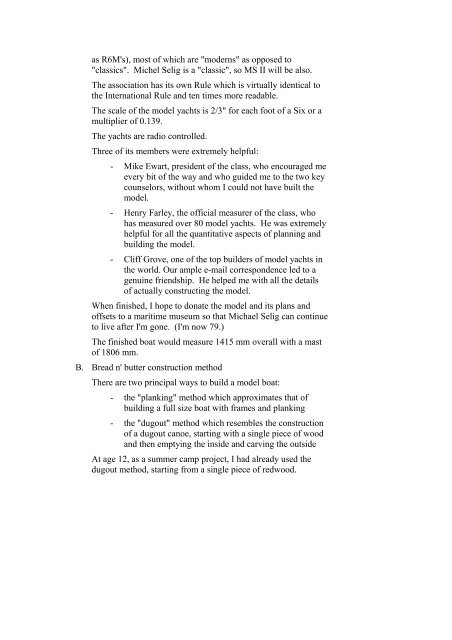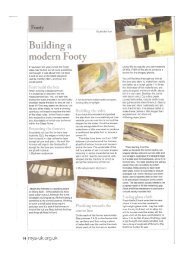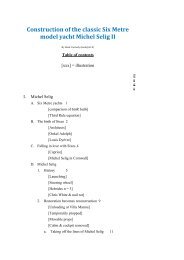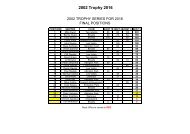Michel Selig II
The Construction of The Classic Six Metre Model Yacht Michel Selig II
The Construction of The Classic Six Metre Model Yacht Michel Selig II
You also want an ePaper? Increase the reach of your titles
YUMPU automatically turns print PDFs into web optimized ePapers that Google loves.
as R6M's), most of which are "moderns" as opposed to<br />
"classics". <strong>Michel</strong> <strong>Selig</strong> is a "classic", so MS <strong>II</strong> will be also.<br />
The association has its own Rule which is virtually identical to<br />
the International Rule and ten times more readable.<br />
The scale of the model yachts is 2/3" for each foot of a Six or a<br />
multiplier of 0.139.<br />
The yachts are radio controlled.<br />
Three of its members were extremely helpful:<br />
- Mike Ewart, president of the class, who encouraged me<br />
every bit of the way and who guided me to the two key<br />
counselors, without whom I could not have built the<br />
model.<br />
- Henry Farley, the official measurer of the class, who<br />
has measured over 80 model yachts. He was extremely<br />
helpful for all the quantitative aspects of planning and<br />
building the model.<br />
- Cliff Grove, one of the top builders of model yachts in<br />
the world. Our ample e-mail correspondence led to a<br />
genuine friendship. He helped me with all the details<br />
of actually constructing the model.<br />
When finished, I hope to donate the model and its plans and<br />
offsets to a maritime museum so that Michael <strong>Selig</strong> can continue<br />
to live after I'm gone. (I'm now 79.)<br />
The finished boat would measure 1415 mm overall with a mast<br />
of 1806 mm.<br />
B. Bread n' butter construction method<br />
There are two principal ways to build a model boat:<br />
- the "planking" method which approximates that of<br />
building a full size boat with frames and planking<br />
- the "dugout" method which resembles the construction<br />
of a dugout canoe, starting with a single piece of wood<br />
and then emptying the inside and carving the outside<br />
At age 12, as a summer camp project, I had already used the<br />
dugout method, starting from a single piece of redwood.







